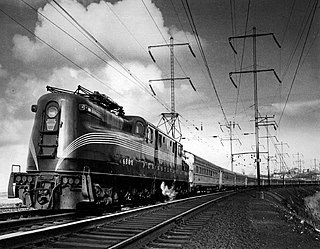Related Research Articles

The Pennsylvania Railroad GG1 is a class of streamlined electric locomotives built for the Pennsylvania Railroad (PRR), in the northeastern United States. The class was known for its striking art deco shell, its ability to pull trains at up to 100 mph, and its long operating career of almost 50 years.

The Great Train Wreck of 1918 occurred on July 9, 1918, in Nashville, Tennessee, United States. Two passenger trains, operated by the Nashville, Chattanooga and St. Louis Railway ("NC&StL"), collided head-on, costing at least 101 lives and injuring an additional 171. It is considered the worst rail accident in U.S. history, though estimates of the death toll of this accident overlap with that of the Malbone Street Wreck in Brooklyn, New York, the same year.

A hot box is the term used when an axle bearing overheats on a piece of railway rolling stock. The term is derived from the journal-bearing trucks used before the mid-20th century. The axle bearings were housed in a box that used oil-soaked rags or cotton to reduce the friction of the axle against the truck frame. When the oil leaked or dried out, the bearings overheated, often starting a fire that could destroy the entire railroad car if not detected early enough.

Frankford Junction is a railroad junction, and former junction station, located on the border between the Harrowgate neighborhood of Philadelphia and Frankford, Philadelphia. At the junction, the 4-track Northeast Corridor line from Trenton connects with the 2-track Atlantic City Line from Atlantic City in the northeastern portion of Philadelphia about 2.9 miles (4.7 km) northeast of North Philadelphia station. It lies near the intersection of Frankford Avenue and Butler Street, to the west of the interchange between Interstate 95 and the approach to the Betsy Ross Bridge. It has been used for rail transportation since 1832 but has not served as a station since October 4, 1992.
The 1922 Winslow Junction train derailment was a July 2, 1922 accident on Atlantic City Railroad's Camden to Atlantic City route. Train № 33 the Owl going 90 miles (140 km) per hour sped through an open switch at Winslow Junction. 7 were killed, 89 were injured.
The Redondo Junction train wreck occurred at 17:42 on the evening of January 22, 1956, on the Santa Fe Railroad in Los Angeles. The accident happened at Redondo Junction, California, just southwest of Boyle Heights near Washington Boulevard and the Los Angeles River; it killed 30 people and injured 117 more. It was the first major disaster in the LA area covered on live television, and the worst train wreck in the city's history.
The "Hightstown" rail accident occurred on the Camden and Amboy Railroad between Hightstown, New Jersey and Spotswood on November 8, 1833, just two months after horses were replaced by steam locomotives on the line. It is the earliest recorded train accident involving the death of passengers in America.

The Rockport train wreck occurred in Rockport in Mansfield Township, New Jersey, United States, about three miles outside of Hackettstown, on June 16, 1925. A violent storm washed debris onto a grade crossing, derailing a Lackawanna Railroad (DL&W) train. The crash killed 42 passengers and five crewmen and injured twenty-three others.

The 2015 Philadelphia train derailment of a New York City-bound Amtrak train in Kensington, Philadelphia, Pennsylvania in the United States resulted in multiple passenger injuries and deaths and disrupted Amtrak service for several days afterward due to the resulting investigation and removal of the wrecked train cars.
The Lackawanna Limited wreck occurred when a Delaware, Lackawanna and Western Railroad (DL&W) passenger train, the New York-Buffalo Lackawanna Limited with 500 passengers, crashed into a freight train on August 30, 1943, killing 29 people in the small Steuben County community of Wayland in upstate New York, approximately 40 miles (64 km) south of Rochester.
References
- ↑ Passenger Train Consists of the 1940s. Wayner Publications. p. 18.
- 1 2 ICC Investigation No.2726
- 1 2 Philadelphia, PA Congressional Limited Train Wrecks, Sep 1943 Archived 2012-03-26 at the Wayback Machine Philadelphia, PA Congressional Limited Train Wrecks, Sep 1943
- The Derailment of the Congressional Limited, Pennsylvania's Worst Railroad Disaster by Benjamin L Bernhart, publ Outer Station Project 2007, ISBN 1-891402-08-0